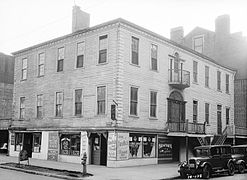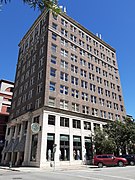Reynolds Square (Savannah, Georgia)
 The John Wesley statue in the square | |||
| Former name(s) | Lower New Square | ||
|---|---|---|---|
| Namesake | Captain John Reynolds | ||
| Maintained by | City of Savannah | ||
| Location | Savannah, Georgia, U.S. | ||
| Coordinates | 32°04′45″N 81°05′21″W / 32.0793°N 81.0892°WCoordinates: 32°04′45″N 81°05′21″W / 32.0793°N 81.0892°W | ||
| North | Abercorn Street | ||
| East | East St. Julian Street | ||
| South | Abercorn Street | ||
| West | East St. Julian Street | ||
| Construction | |||
| Completion | 1734 | ||
Reynolds Square is one of the 22 squares of Savannah, Georgia, United States. It is located in the first row of the city's five rows of squares, on Abercorn Street and East St. Julian Street. It is east of Johnson Square, west of Warren Square and north of Oglethorpe Square. The oldest building on the square is The Olde Pink House (originally Habersham House), which dates to 1771.[1]
Originally called Lower New Square (due to its being the first one laid out, in 1734, after the original four), it was later renamed for Captain John Reynolds, governor of Georgia in the mid-1750s. Reynolds was, in fact, an unpopular governor, and it is said that the celebration held upon his arrival in the colony was rivaled only by that held upon his departure.[2]
The square contains a bronze statue, by Marshall Daugherty, honoring John Wesley, founder of Methodism. Wesley spent most of his life in England but undertook a mission to Savannah (1735–1738), during which time he founded the first Sunday school in America. The statue was installed in 1969 on the spot where Wesley's home is believed to have stood.[3][4] The statue is intended to show Wesley preaching out-of-doors as he did when leading services for Native Americans, a practice which angered church elders who believed that the Gospel should only be preached inside the church building.[5]
Reynolds Square was the site of the Filature,[6] which housed silkworms as part of an early—and unsuccessful—attempt to establish a silk industry in the Georgia colony.[7][8]
Dedication[]

The square is named for Royal Navy officer John Reynolds (c. 1713–1788)
Constituent buildings[]
Each building below is in one of the eight blocks around the square composed of four residential "tything" blocks and four civic ("trust") blocks, now known as the Oglethorpe Plan. They are listed with construction years where known.
- Northwestern trust/civic block
- Habersham House, 23 Abercorn Street (1771)[1] – oldest building on the square; now The Olde Pink House
- 24 Drayton Street (1924)
- Southwestern trust/civic block
- Planters Inn, 29 Abercorn Street (1913)[1]
- Oliver Sturges House, 27 Abercorn Street (1813)
- Southwestern residential/tything block
- 31–39 Abercorn Street (1920)[1]
- (The Mackay House, 125 East Congress Street – demolished; a parking garage now occupies the location)
- Northeastern residential/tything block
- Southeastern trust/civic block
- 28 Abercorn Street (1919)[1]
- Southeastern residential/tything block
- Lucas Theatre, 32 Abercorn Street (1921)
Gallery[]

9 Lincoln Street

Lucas Theatre, 32 Abercorn Street

The Mackay House, 125 East Congress Street (now demolished)

Planters Inn, 29 Abercorn Street
Oliver Sturges House, 27 Abercorn Street

The Olde Pink House, 23 Abercorn Street

24 Drayton Street
References[]
- ^ a b c d e f g h Historic Building Map: Savannah Historic District – Historic Preservation Department of the Chatham County-Savannah Metropolitan Planning Commission (November 17, 2011), p. 11
- ^ Chan Sieg (1984). The squares: an introduction to Savannah. Virginia Beach: Donning.
- ^ City of Savannah's monuments page This page links directly to numerous short entries, many accompanied by photographs, discussing a variety of monuments, memorials, etc., in the squares and elsewhere. Accessed June 16, 2007.
- ^ Official Savannah Guide's Tour Savannah's Squares, accessed June 16, 2007.
- ^ See Savannah by T.D. Conner (2001), accessed June 14, 2007
- ^ Filature
- ^ Tour Guide Manual for licensed tour guides in the City of Savannah, accessed June 16, 2007.
- ^ Savannah Scene magazine, May–June 2007, pp 10–11, accessed June 16, 2007.
- Reynolds Square, Savannah
- 1734 establishments in the Thirteen Colonies








